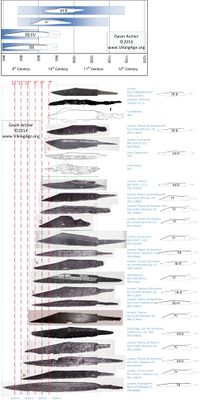
I feel very privileged to have made the acquaintance of Ambar Bahadur Bishwokama, a very accomplished swordsmith and knifemaker from Kathmandu and owner of KC Nepal (
https://nepalkhukurihouse.com/). It´s obviously that I have developed a fascination with Nepalese cutlery and with the hard-working craftsmen who are able to create beautiful knives with next to no equipment. This is an inspiration to me, and this is what "Tribal Knifemaking" as we Westerners call it out of a grave misunderstanding, is all about. We tend to see this as romantic, but it is not. It is the way these guys make a living. And in my opinion, they can be very proud. It is not about the fancy tools, it is in the skills that make the knife.
Coincidentally, I also feel very privileged to have made the acquaintance of some Ms. Janet Fischer ;-), owner of
www.nordisches-handwerk.de, retailer of fine Scandinavian and bushcraft knifes, materials and fine art in Germany, and chance is, they had a design for a seax lying about don´t doing anything. Some PMs on facebook later and we had a collaboration going, not always easy, but a communication no less (message included for a mad world). In fact, Ambar went outright enthusiastic about the knife and forged away in no time.

The knives are made from high-carbon spring steel. And next time you whine about not having the equipment to start making knives or tools better shut up- this is how they do it the traditional way. Those are exactly the same tools common in Europe in the viking age. So, while the design of the knife might not exactly be period, the manufacturing process is actually nearly the same as they might have done it in the viking age.

Safety boots? Quit whining!

Roughing out the tang... fullering tool?

What you need is a hammer and tongs-and skill.




The handle roughly hewn...

...would not stay that way for long!
The finshed product surely does not fill the bill of some showcase viking, and of course it would not do for museum reenactors. Taking some liberties, you could see it as similar to some Anglo-Saxon types (See: Wheeler Seax typology)

But keep one thing in mind: In general, you can get a lot of knives for reenactment camp chores. And a lot of them are crap. I am meaning no offence, but there are a lot of smiths on reenactment frairs around thes parts who are better at drinking than at smithing, so to say. This knife is made like a Khukuri and quenched in the same manner. I hope to be able to provide you with a video of a brutal test soon. As far as I can say for now, I am very intrigued by the knife and that does not happen easily!
You can get them soon from
www.nordisches-handwerk.de in the shop or you can write them an Email at kontakt [ätt) nordisches minus handwerk dot de.


 Safety boots? Quit whining!
Safety boots? Quit whining! Roughing out the tang... fullering tool?
Roughing out the tang... fullering tool?  What you need is a hammer and tongs-and skill.
What you need is a hammer and tongs-and skill.


 The handle roughly hewn...
The handle roughly hewn... ...would not stay that way for long!
...would not stay that way for long!









